‘Every well groomed woman is very particular to see that outside garments fit without wrinkles and with a glove-like appearance across the hips and back. […] The fitted princess slip has come into use to overcome this difficulty’ (School Sewing Based On Home Problems, 1916).
I’m currently sewing an Edwardian lace lingerie dress and I made this Edwardian princess slip to wear underneath. Princess slips were an alternative to a separate petticoat and corset cover (camisole) in the 1900s. Because princess slips fit smoothly over the body and don’t have a seam at the waist they were considered superior to underwear with waist seams. But they are also more difficult to make than a separate petticoat and camisole! 😉
Actually, I’d already made a matching petticoat and camisole to wear under my Edwardian lace lingerie dress. Click on the link below to see it. 🙂 However, I didn’t like the bulk it created at the waist. That’s why I made this Edwardian princess slip instead! 😀
Related: Edwardian Green Artificial Silk Petticoat & Camisole
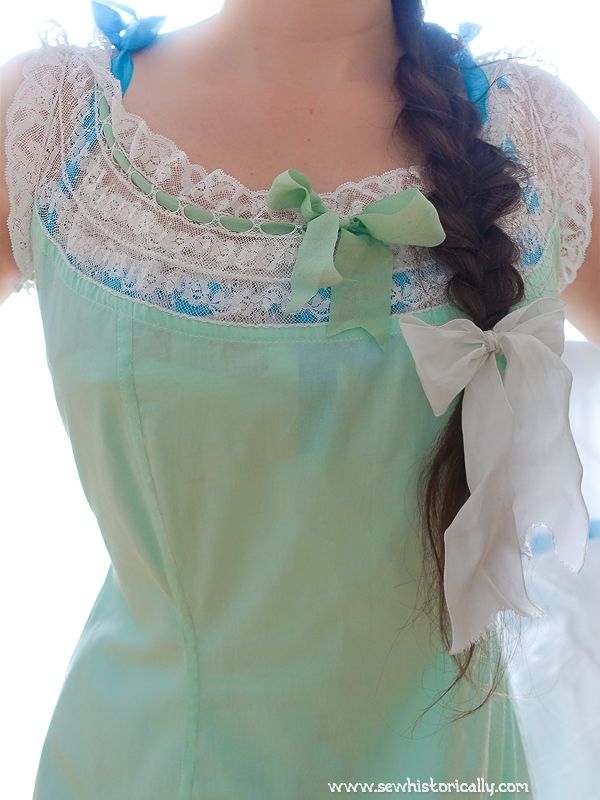
Pattern & Fabric
‘The pattern for a princess slip is difficult to draft’ (School Sewing Based On Home Problems, 1916).
I drafted the pattern for my Edwardian princess slip based on antique 1900s princess slips. It took several mockups to finally get the fit right! I’m wearing my Edwardian princess slip over my Edwardian combination and my Edwardian cotton net summer corset.
Related: Edwardian Cotton Net Summer Corset
For my Edwardian princess slip I used mint green cotton batiste which is slightly sheer: that’s why you can see my Edwardian summer corset through it in these photos! 😀 I bought 7m (275″) of mint green cotton batiste. And I also needed the full 7m of fabric with almost no waste of fabric to make my princess slip!
Valenciennes Lace
Because princess petticoats were only worn for special occasions like summer afternoon garden parties, they were usually richly decorated with lace. I used cotton Valenciennes lace to embellish my princess slip. Valenciennes lace was the most popular lace for underwear in the Edwardian era.
Related: How To Dress In The Edwardian Era
I sewed the lace yoke by hand and threaded pure silk ribbon through the beading lace which I dyed pale green to match the color of the cotton batiste.
Related: How To Make An Edwardian Lace Yoke
Then I embellished the top ruffle of my Edwardian princess slip with two rows of cotton Valenciennes lace inserts and a wide Valenciennes edging lace at the hem. I also added two wide tucks between the lace inserts because tucks and lace were often used together on Edwardian cotton petticoats & slips.
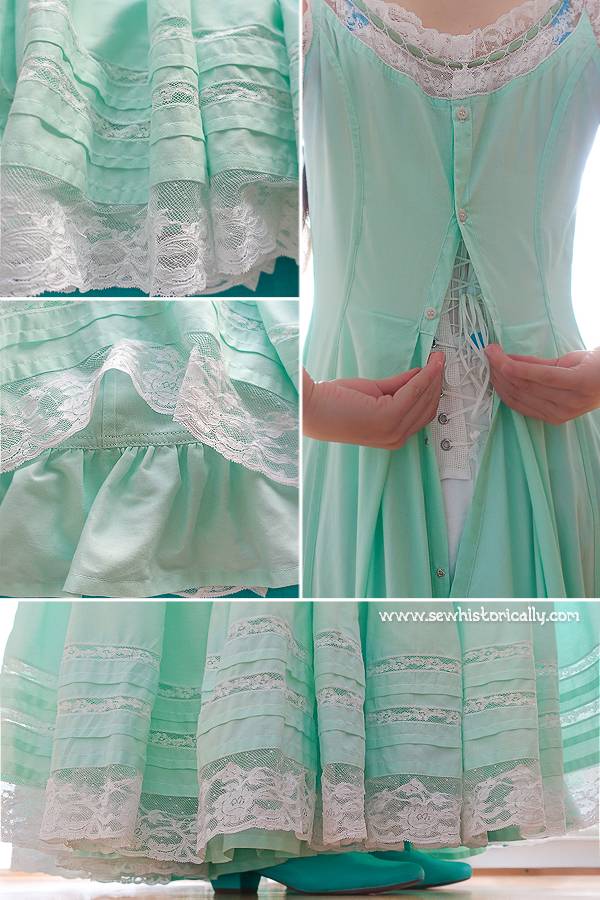
Related: DIY Mint Green Painted Shoes
‘The trimming for the upper part of the waist may be made as elaborate as desired because the slip takes the place of the regular corset cover. The bottom of the slip may be trimmed with ruffles, with lace, with rows of insertion sewed together to make a flounce, with embroidery, with beading and insertion, or may even be left plain.’ (School Sewing Based On Home Problems, 1916)
Top Ruffle & Dust Ruffle
By the way, there are two layers of fabric at the hem of the slip. Edwardian petticoats and slips often had two ruffles at the hem: a dust ruffle (under ruffle) and the top ruffle. The top ruffle of my Edwardian princess slip is very full to help support the skirt of my Edwardian lace lingerie dress. The hem circumference of the top ruffle is 9m (355″)! 😀
And under it is a small dust ruffle which almost all Edwardian petticoats and slips had.
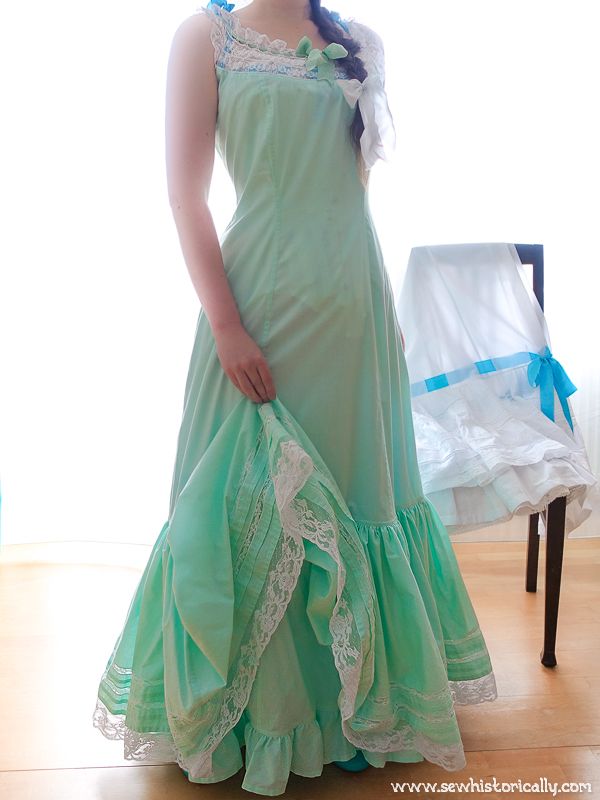
Lace Inserts Like In The Edwardian Era
In the Edwardian era, lace was never inserted with zig zag stitches. So, after I inserted the lace, I finished the raw edges with tiny hems like it was done in the Edwardian era. If you want to know how lace was inserted in the Edwardian era, click on the link below.
Related: 6 Ways How To Insert Lace – Historical Sewing Tutorial
Inserting 18m of lace with 36m of tiny hems and sewing 18m of tucks is no fun! 😉 But I love how it turned out! 😀 And I have even more lace to insert and even more pintucks to sew on my Edwardian lace lingerie dress: so it was good practice! 😉
And the tiny hems together with the tucks help to stiffen the hem creating the fashionable early Edwardian mermaid skirts. Hems of Edwardian underwear can never be stiff enough to support the wide skirts of the early Edwardian era! 😉
Flat Felled Seams & Receiving Tuck To Attach The Ruffle
All seams of my princess slip are flat felled seams because they are also neat on the wrong side, are easy to iron and are a strong seam finish.
Related: 34 Types of Seams – Historical Sewing
‘Either French or felled seams may be used to join the seams on this garment.’ (School Sewing Based On Home Problems, 1916)
And I used the Edwardian receiving tuck again to attach the top ruffle and finish all raw edges in one step.
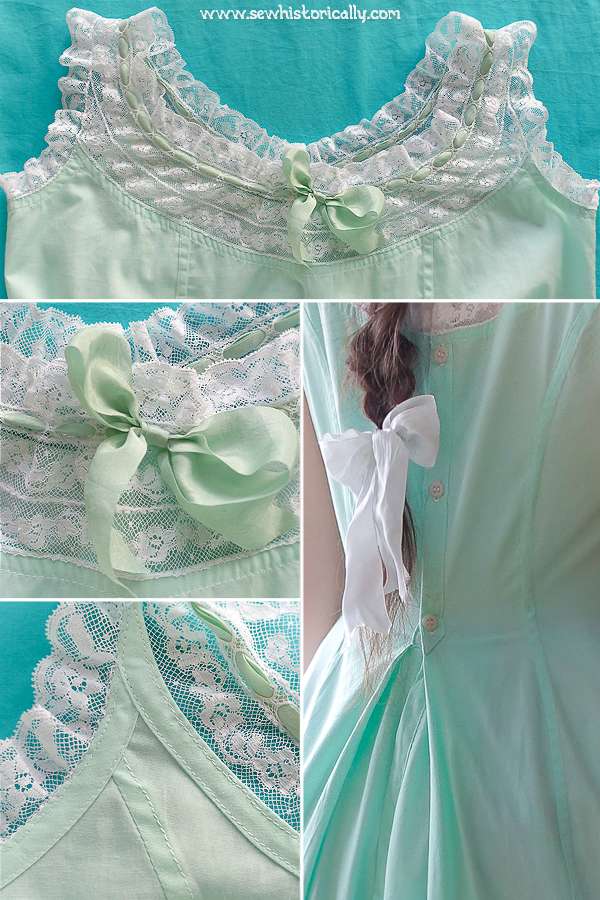
Self-Fabric Bias Facing
Before I attached the lace with overhand stitches by hand I finished the neckline and armholes with self-fabric bias facing. Self-fabric bias facing is my new favorite way to finish raw edges around the neckline and armholes: I learned it from Edwardian sewing instructions! 😀 Self-fabric bias facings are easy and fast to make and look neat.
‘Finish the armholes with bias strips of the material cut about 1″ wide […] Overhand lace on the edge of the arm-hole after it is faced’ (School Sewing Based On Home Problems, 1916).
Button & Snap Closure
Because princess slips were usually worn by well-off women who had a maid to dress them, they usually had a center back closure.
Related: Dressing The Edwardian Woman
My Edwardian princess slip is closed at the center back with three buttons above the waist and two snaps below the waist. Snap closures are almost invisible that’s why they were often used in the 1900s for invisible closures. And the Valenciennes lace yoke is also closed with one snap at the center back.
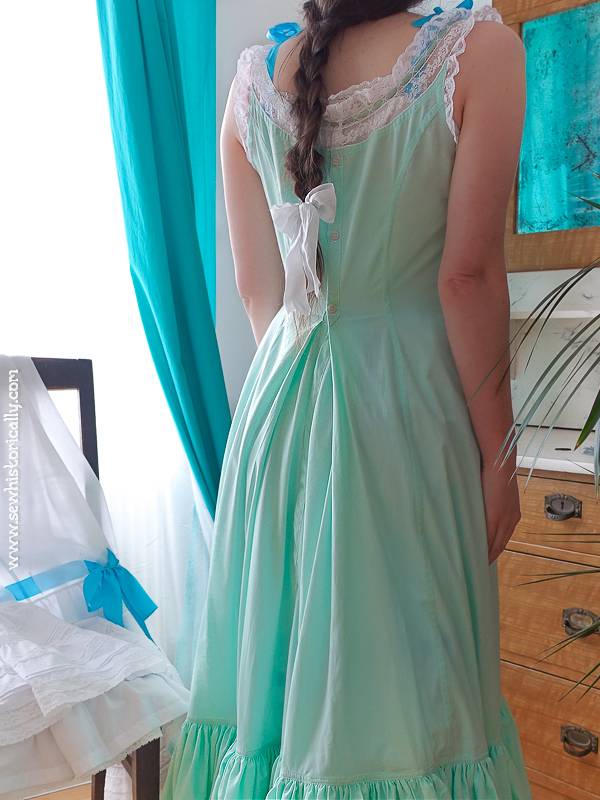
Leave ‘an opening at the top of the center front or back seam long enough to allow the garment to slip over the head easily. […] Finish the placket opening with an extension placket […] To fasten it together, sew about 6 snaps […] on the placket or work the same number of buttonholes and sew on small pearl buttons to correspond with them.’ (School Sewing Based On Home Problems, 1916)
Inverted Box Pleat
My Edwardian princess slip has an inverted box pleat at the center back. Inverted box pleats were a popular detail on skirts, petticoats and slips in the Edwardian era because it added extra width. It also made the bum look bigger which was really popular in the 1900s! 😉
Antique Edwardian Princess Slip Inspirations
By the way, princess slips were also known as ‘princess petticoat’ or ‘combination petticoat and camisole’ in the Edwardian era.
The main inspiration for my Edwardian princess petticoat was this beautiful antique Edwardian pink batiste princess slip with off-white Valenciennes lace insertions. Here’s a different view of the same princess slip, a close-up of the lace yoke and a close-up of the lace insertion at the hem. Also, this antique Edwardian princess slip at the MET museum with a wide hem ruffle with tucks & lace inserts was the main inspiration for the ruffle of my 1900s princess slip.
‘Every well groomed woman is very particular to see that outside garments fit without wrinkles and with a glove-like appearance across the hips and back. There is only one way to accomplish this result, and that is to have the under garments without fullness or wrinkles. […]
The fitted princess slip has come into use to overcome this difficulty for it is so made that the under skirt and corset cover make a continuous line from the shoulder to the bottom of the skirt.’ (School Sewing Based On Home Problems, 1916)
Other inspirations for my Edwardian princess slip were the following antique Edwardian princess slip: 1900s mint green china silk princess slip with Valenciennes lace, Edwardian white cotton princess petticoat with a wide ruffle at the hem with pintucks & Valenciennes lace inserts, and another cotton & lace princess slip.
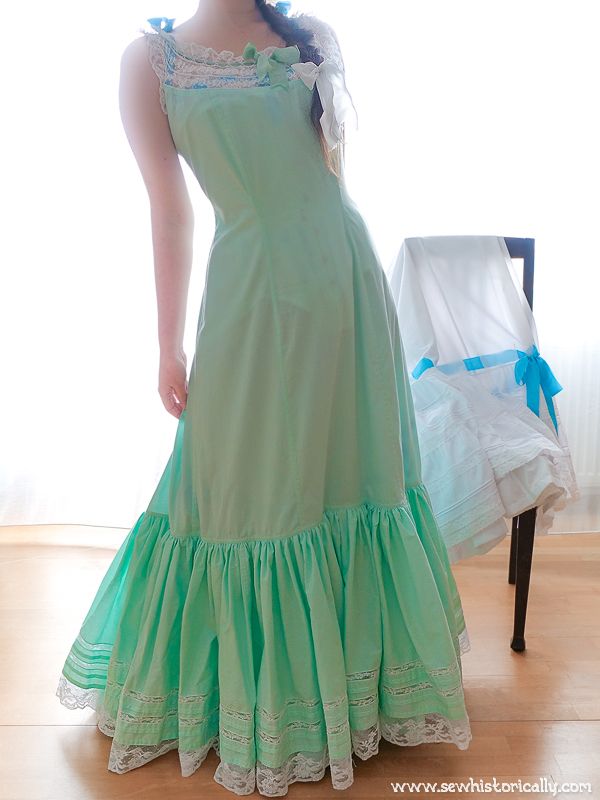
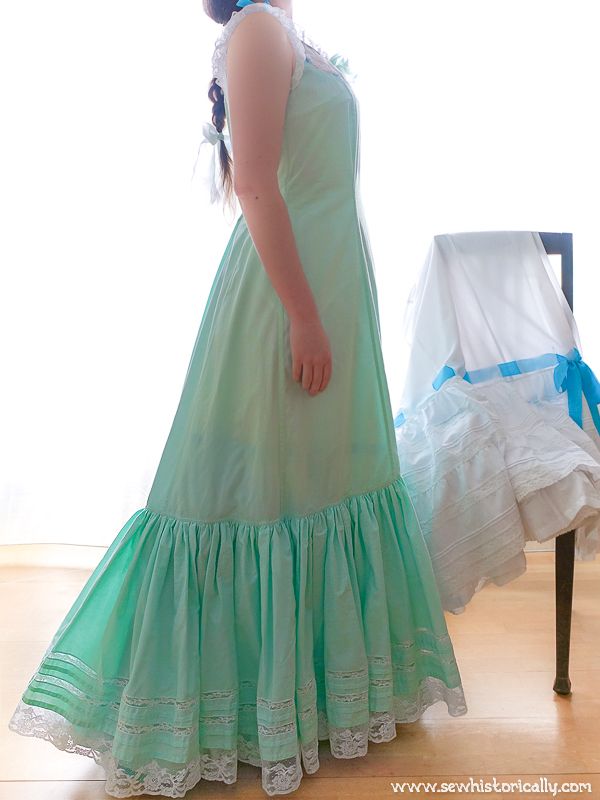
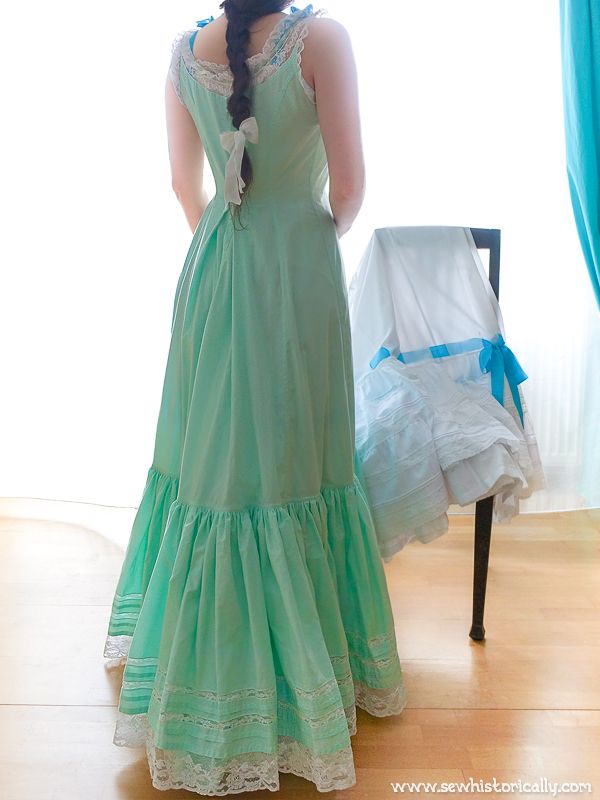
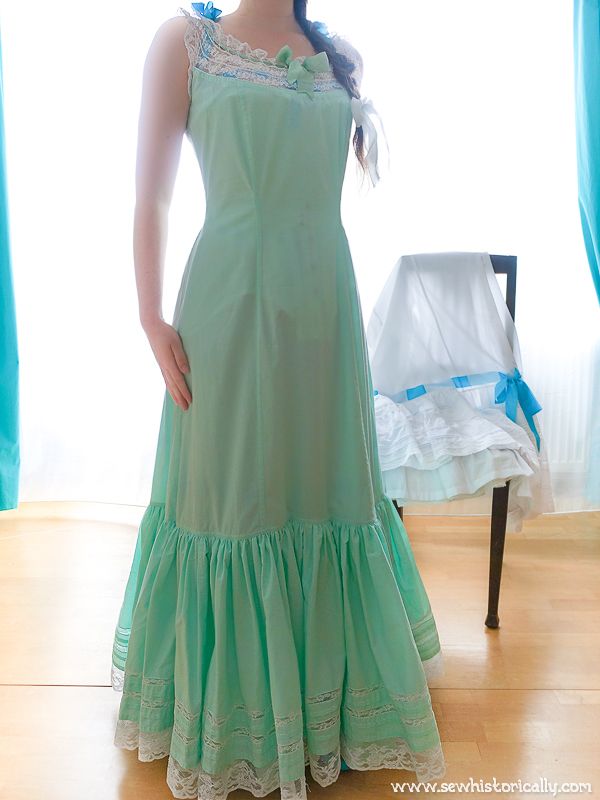
Simply stunning!
Thank you for sharing such a wonderful masterpiece!
Wishing you a lovely month of December
X Daniela
Thank you so much! 😀